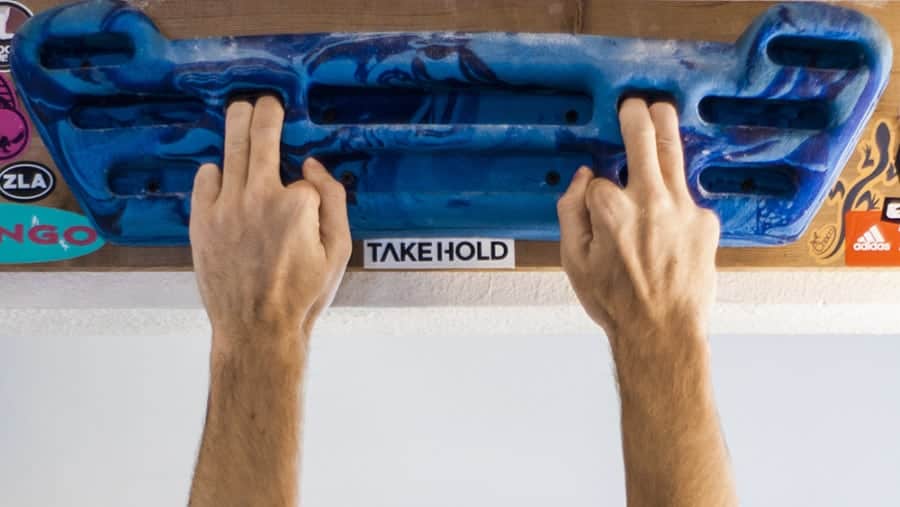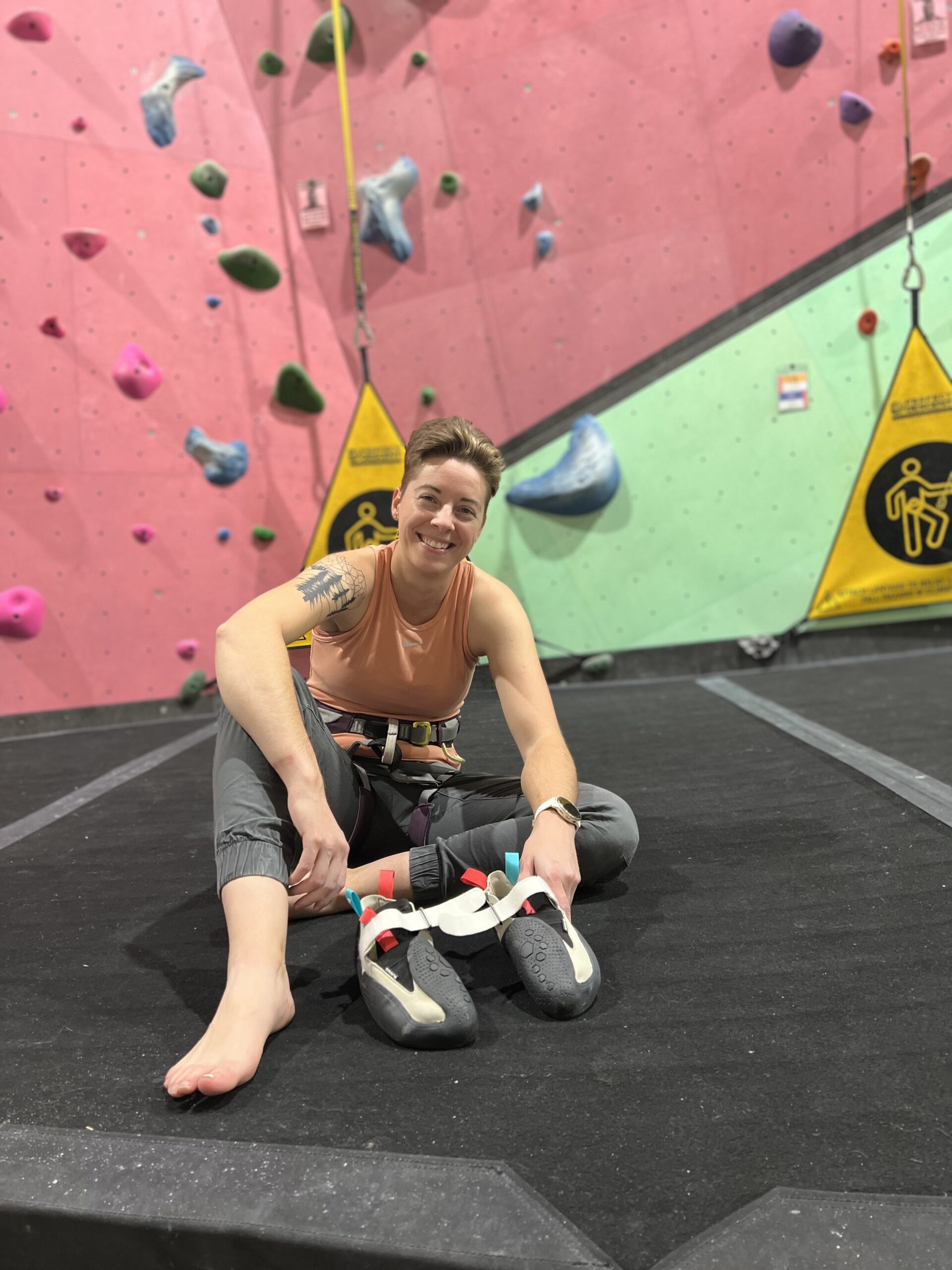Hangboarding is known for being a great training tool for increasing your grip strength and grip technique. However, there is a lot of contradicting information for when it is safe to start hangboard training.
When should boulders start hangboarding? The most common recommendation for boulderers is to wait until you have been bouldering for at least a year with at least 2 climbing days per week during that year. However, you can start hangboarding as early in your training as you like as long as you have the discipline and understanding of hangboard training so that you can do it safely.
Hangboard training will help with build your grip strength but most climbers would benefit more from technique training than additional grip strength.
What is Hangboard Training For?
Most hangboard training regimens require you to hold a specific position for 10ish seconds and then take a minute rest. These types of training regimens build grip strength training and can help boulderers learn to use different size edges and types of climbing holds efficiently.
In addition, many boulderers use a hangboard to build entire body strength by using the hanging time to practice ab workouts or even pull-ups. Prior to adding the full body workouts to your hangboard regimen, it is important to get grip technique and hanging down first so that you don’t injure tendons while attempting more difficult positions and movements.
Do Boulderers Benefit From Hangboard Training?
Hangboard training does help with grip strength, which is often a limiting factor for new climbers. However, the gains from hangboard training is usually disappointing compared to technique and mental training.
For example, most beginner and intermediate boulderers over grip due to a lack of mental training. This makes it so that they need more grip strength to keep climbing. However, if they gripped softer on the holds (the minimum amount needed) they’d find that most of the climbs they do are perfectly suitable for their grip strength. Including the crimpy climb in the corner of the gym.
The body movement and footwork technique you use, for example, will also affect how much forearm and finger strength you need because depending on your body position, you may not need as much hand and arm strength that you think you need.
For this reason, most professional climbers and bouldering trainers recommend that new and intermediate climbers focus on building technique, then mental strength, and then physical strength such as grip strength on a hangboard last.
In most cases (unless your ready for the olympics), the strength that you gain from focusing technique will be adequate for any climb you want to accomplish.
Why Should You Wait To Train on a Hangboard?
Most climbers recommend that you wait until you are at least a year into climbing with significant experience prior to hangboard training. But why? Hangboarding takes a lot of tendon strength and unlike muscles, you can’t just build these up by lifting heavier weights. Instead, tendon strength is built by using them over and over again. Not by adding weights to your belt.
Unfortunately, beginner climbers haven’t learned their true limits in regards to the small hand tendons and often end up injuring their hands while hangboard training. Pair an injury and not being able to climb (due to the injury) and you lose a lot more than any potential gains you would have gotten from hangboard training.
Alternative Exercises to Hangboard Training
If you want to build grip strength without the risk (or cost of buying a hangboard) then there are many alternatives that can help you build grip strength. I have a full list of exercises and how to do them here.
- Plate Hold: Hold a 15-45 pound (depending on your strength) weighted plate in each hand until your grip fails. If you want to make this exercise even more difficult, pinch two plates together in each hand. Trust me, pinching two plates together is a lot harder than it looks.
- Dead Hang: If you’ve ever done crossfit, then you’re probably already familiar with this exercise. The exercise is to hang from a pull-up bar while pulling your shoulders back and pushing your chest up for 1 minute. If you want it to be even more difficult, swing a towel over the pullup bar and have one hand on the bar while the other hand holds onto the towel for balance.
- Boa Constrictor Ring Grip: Using a ring grip trainer, grip the trainer and squeeze the ring. Hold your hand closed for at least 10 seconds and then slowly release the tension of your grip for as long as you can.
See 12 grip training exercises guild here
When is Hangboarding Safer Than Climbing?
Because so many people have gotten injured from climbing, you don’t usually find details about when hangboarding is safer than climbing. However, crimp climbing can be just as dangerous if not even more dangerous than hangboarding.
For example, on a crimpy climb, you may lose your footing and drop your entire weight onto your fingers. In comparison, while you are hangboarding, you are in a controlled environment and you can track the time, weight and force that you are inflicting on your finger tendons so you can minimize risk of injury.
In addition, if you are working on a super crimpy climb, you can try to hold onto the starting hold over and over again, or you could take the grip strength training to the hangboard and usually get the grip gains faster than if you just repeated your attempt to start that climbing route over and over again.
How Often Should You Train on a Hangboard?
Hangboard training takes a lot of effort and tendon strength so it is ideal to minimize your hangboard training to once or twice per week, depending on how often you climb.
For days that you are hangboard training, ensure that you do a nice warmup for your fingers and then do the hangboard training before a climbing session. If you do it after a climbing session, you are more likely to make mistakes and overuse your tendons. In addition, pay attention to how your grip feels while you are climbing so you don’t overuse your tendons while climbing. If you feel pain in your hands, stop climbing.
After a few weeks of hangboard training, consider focusing on something else like footwork or training for power.
Can you Hangboard Everyday?
It really isn’t ideal to hangboard everyday. Your tendons need recovery time, even more so than your muscles. If you hangboard everyday you are increasing your risk of injury and even decreasing the gains you would have gotten if you allowed your hands to recover.
For this reason, it is ideal to hangboard for a maximum of 2-3 days per week and even less if you are climbing 2-3 days per week.
Should I hangboard before or after climbing?
Hangboarding is most effective after a warm-up and before climbing. This will minimize your risk of injury while hangboarding so you don’t overuse your finger tendons.
Many climbers choose to hangboard on days that they aren’t climbing so that they don’t compromise their climbing training with the exhaustion of hangboarding. However, you need recovery time for your hands and if you are climbing on days that you aren’t hangboard training, then you aren’t getting that recovery time.
How Long Should a Hangboard Session Be?
After a thorough warm-up, your hangboard sessions are usually around 5 minutes long, including long rest periods.
If you are considering hangboard training, then you would probably benefit from trying out a hangboard training app on your phone or a routine from a climbing training manual. Consider using a tested hangboard routine instead of making up your own.
More About Training for Climbing:
- How To Climb More Often Without Getting Injured | Tried And Tested Methods For Recovery
- Lower Body Mobility And Flexibility Challenge
- Neglected Techniques Necessary For V4-V5 Progression
- 17 Footwork Drills For Climbing
- Mental Training For Climbing
- How Often And Hard Should You Climb To Get Gains?
- When Should You Start Hangboarding For Boulder’s
- Is Bouldering When Sore Bad?
- The Top 22 Climbing Techniques And Skills And How To Do Them
- 23 Tips For Climbing Slabs
- When To Flag In Climbing And How-To-Do It (With Videos)
- How To Learn Climbing Technique For Beginners
- What Should You Record In A Climbing Journal?
- Climbing Endurance: Muscle, Skin And Mental Training
- How To Deal With Fear Of Falling
- How Many Days Should You Climb Per Week?
- 5-10 Minute Warm-Up For Climbing
- What Is A Dyno And How To Do It
- What Is A Gaston In Climbing? Powerful Moves For Beginners
- Can Foam Rolling Improve Rock Climbing Performance?
- 7 Things Climbers Should Do On Rest Days For Better Performance
- When Do You Need A Rest Day?
- How To Climb Your Best – Pros And Cons Of Rest Days
- Static Vs Dynamic Climbing Movement: Pros And Cons
- 5 Habits For Healthy Climbing That You Haven’t Thought Of
- 5 Things To Improve Climbing Performance And Sustainability
- 10 Minute Workout Routines For Post Climbing Sessions
- How To Use Climbing Holds: Techniques For Improved Climbing
- A Guide For Climbers: Bouldering Drills 101
- 12 Easy Workouts To Increase Hand And Grip Strength For Climbers
- What Are Undercling Climbing Holds And Why Climbers Love/Hate Them
- What Is A Crimp In Rock Climbing And How To Train For Them
- 7 Common Mistakes in Rock Climbing For Beginners


